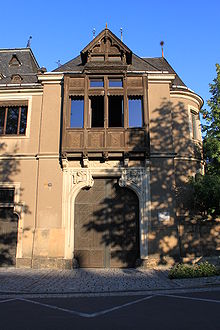Zschille Villa
The property, known colloquially as the Zschille Villa , is located on the promenade ring of the Saxon town of Großenhain at Mozartallee 123. It was bought by entrepreneur Richard Zschille in 1872 and then redesigned using older components from various European regions.
description
As a result of industrialization, several villas in the Wilhelminian style were built in Grossenhain in the area between the Promenadenring and the then newly built Leipzig and Berlin train stations . A new residential building was also built on Mozartallee in 1865. This and other surrounding properties were acquired by the Grossenhain cloth manufacturer and art collector Richard Zschille from 1872 . Until 1894, Zschille had the building rebuilt several times and "integrated historical art fragments from all over the world into the design."
These spoils give the property an architectural and art-historical value. The Gothic gate of the villa was covered with ironwork that was created in Tyrol in 1497 . Former wooden beam ceilings of the Hainer Magdalenenkloster , dated around 1500, were reused in the side buildings. The renovation was also equipped with various wrought iron grilles, railings, gates and fittings, some of which were manufactured in the 18th century for the Prague Hradschin and others in Aachen in the 18th century , while others come from a Prague synagogue and the Großenhain Katharinenkirchhof. A sandstone portal originally built in the Grossenhainer Kleine Lindengasse during the Renaissance in 1547 found a new place inside the building, as did a sandstone staircase from a Bavarian monastery. A draw well from Reiterswiesen from 1579 with the coat of arms of the Würzburg bishop Julius Echter von Mespelbrunn , a nymph well made of sandstone and a well containing a marble column from Pompeii were also reused . At the northeastern end of the property there is an arbor in the Gothic style, equipped with a late Gothic wooden beam ceiling, a coiled wooden column, the end of which is decorated with cornflower ornaments, and a sandstone column marked with the year 1543. Almost all the doors of the building have a historical background, such as one that was made in Tyrol in the 15th century.
There is a garden inside the property.
The Zschille family sold the area in 1901. In 1918, a western part adjacent to Herrmannstrasse was detached. The eastern property at Mozartallee 123 is privately owned with changing owners up to the present day and is now divided into apartments and business premises.
Web links
Individual evidence
- ↑ a b c d Grossenhainer Pflege - A regional history inventory in the area of Großenhain and Radeburg . In: Leibniz Institute for Regional Geography in Leipzig and Saxon Academy of Sciences in Leipzig (Hrsg.): Landscapes in Germany - values of the German homeland . tape 70 . Böhlau Verlag , Cologne, Weimar and Vienna 2008, ISBN 978-3-412-09706-6 , pp. 110-113 .
- ↑ a b c d Information board Mozartallee 123 (Zschille-Haus) . Grossenhain city administration
- ↑ Zschille Villa. A tour of the old town. Grossenhain City Council, 2011, accessed April 20, 2017 .
Coordinates: 51 ° 17 ′ 26 ″ N , 13 ° 31 ′ 39 ″ E
